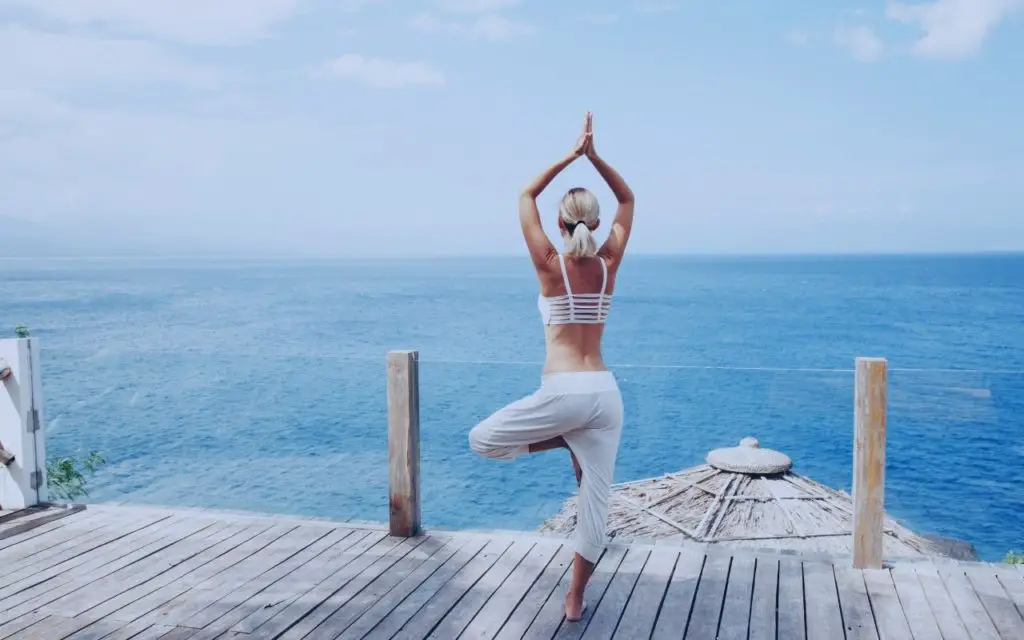
We’d all like to be fit and healthy. But, at times, we find exercise to be such a tedious and exhausting chore that we would rather binge on Netflix or scroll through social media.
Yoga, however, is a less strenuous and easy to modify activity. It is an excellent alternative for those who are wary of full-fledged exercise. It’s also a fun and relaxing activity that will stretch your muscles and provide you with the exercise you require for better health.
What is Yoga
In a nutshell, yoga is an exercise in which you hold various positions to calm your mind and improve your breathing. Yoga poses also stretch, tone, and make your muscles more flexible.
Yoga can thus be thought of as a holistic activity for physical health.
Evolution of yoga
The practice of yoga started several thousands of years ago in Northern India. Originally, yoga was not practiced for physical health but rather for spiritual purposes.
Yoga comes from the Sanskrit root word “Yuj”, which means “to yoke”. Yoking is a practice where a harness is put on an animal, usually around the neck, to perform a task. This practice then unites the animal to a device or another animal in order to get something done.
Yoga then is about uniting the body and the mind to get enlightened.
Yoga however provided other side benefits aside from enlightenment, as such the evolution of yoga from a spiritual practice to a form of physical exercise.
The benefits of yoga
Yoga, from its initial practice of finding enlightenment, surprisingly has physical side benefits as well.
These benefits are:
Improved flexibility
One of the more popular benefits of yoga is that improves your flexibility. This is because of the positions that you need to do with the practice. Furthermore, these positions or poses stretch your muscles with regular practice, resulting in improved flexibility.
Toned and strengthened muscles
Certainly, most yoga poses require you to hold and balance your body weight for a certain period of time. Thus, the continued practice of these poses will definitely tone and strengthen your muscles over time.
Improved posture
In addition to improving flexibility and strength with strong and toned muscles, regular practice of yoga poses naturally improves your posture. You will learn to carry your body in a way that is in sync with your tightened core muscles.
Increased metabolism
Another advantage of yoga is increased metabolism. The breathing techniques employed in yoga increase your intake of oxygen and also warms up your body. The breathing exercise that occurs while doing yoga stimulates the body’s endocrine glands, leading to an increase in metabolic rate.
Improved immunity
Aside from increased metabolism, yoga also calms your nerves. And lowers your stress levels when practiced on a regular basis. Of course, reduced stress levels will definitely benefit the nervous and immune systems as well.
Improved circulation
Yoga, as previously stated, greatly aids in body and mind relaxation. A relaxed body also means more fluid blood flow in the circulatory system. Improved blood flow means more oxygen to the cells, which will energize your body and mind for peak performance.
Lowered blood sugar
Also, Yoga, like any other form of exercise, will help you lower your blood sugar. This is due to the fact that holding those poses increases the muscle’s use of the glucose in your bloodstream. As a result, blood sugar levels are lower and circulation is improved.
Improved sleep
Yoga has been shown to improve mental awareness. This increased mindfulness has an effect on the physical body by increasing melatonin, a substance needed for a good night’s sleep.
Improved heart function
To reiterate, yoga practice focuses on breathing and muscle movement, both of which are beneficial to the heart.
Breathing properly benefits the circulatory system. This system includes the heart, which pumps blood as well as the oxygen and nutrients required by the body.
Improved lung function
Finally, another great side effect of yoga for your body is improved lung function. Again, this is primarily due to the practice’s emphasis on breathing, which fully inflates and deflates lung muscles. As a result, lung capacity increases, as does breath and oxygen intake.
Practical reasons to choose yoga as exercise
Aside from the physical and mental benefits of yoga, there are other advantages to this exercise. The following are the most important practical reasons for choosing yoga as an exercise:
- No need for expensive equipment,
- Uses your body weight,
- You can practice yoga at home,
- You can do it barefoot. There is no need to put on your shoes.
- You can wear whatever you want. There are no specific clothing requirements.
Best yoga poses for beginners
If you’ve read this far, I hope I’ve persuaded you to give yoga a try. For starters, here are some beginner-friendly yoga poses or asanas you can try.
Tadasana or Mountain pose
To perform this pose, stand up straight with your feet together. Distribute your weight evenly between both feet. Allow your shoulders to relax. Inhale deeply and raise your arms overhead.
Alternatively, you can place your hands in a prayer position in front of your chest or simply rest them by your sides.
Take long, deep breaths through the nose and hold this pose for 3–5 breaths.

Bhujangasana or Cobra pose
The cobra pose entails that you lie face down on your mat with legs stretched out behind. And the tops of your feet on the ground, with toes, pointed.
Next, place both your hands, palms facing down directly underneath your shoulder blades, and prepare to lift your upper body and head.
Press your hands and gently move your chest forward and up. Straighten your arms as much as you can but make sure not to strain your back.
Look slightly up and ensure the back of your neck is long to ensure proper spinal alignment. Stay in this position for 5-10 breaths, maintaining spinal alignment.
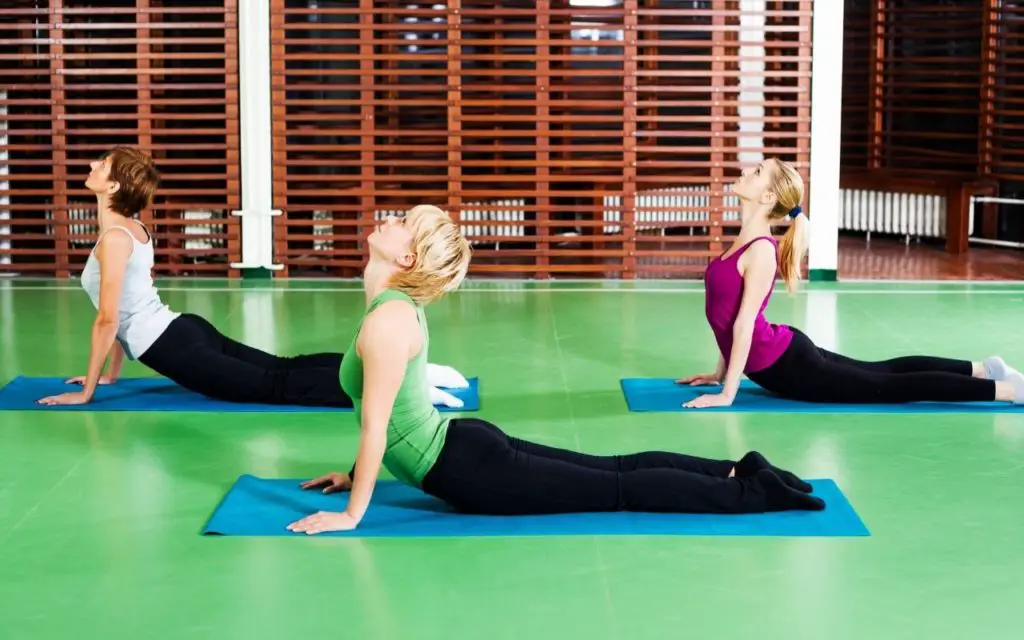
Ado Mukha Svanasana or Downward-facing dog
Start on your hands and knees, placing your wrists beneath your shoulders and your knees beneath your hips.
Draw your hips toward the ceiling by pressing your buttocks up and back. Straighten your legs as much as you can and gently press your heels into the floor.
This pose looks like an inverted “V.” Again, hold this pose for 5-10 breaths.
The main goal of this pose is to keep the spine long. So, if you need to bend your knees, that’s fine.
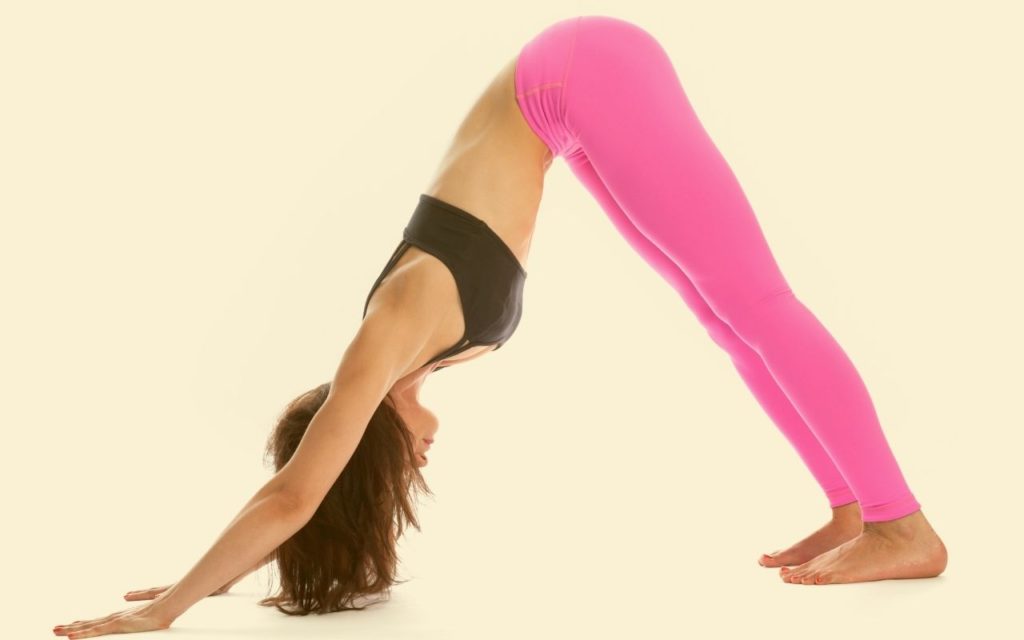
Utthita Ashwa Sanchalanasana or Crescent lunge
With your left foot, take a big step forward. Bend your forward knees to a 90-degree angle while keeping your back leg straight and your heel lifted off the floor.
Keep your hips parallel to the floor then raise your arms towards the ceiling.
Hold this position for 5 breaths before repeating it on the opposite side.
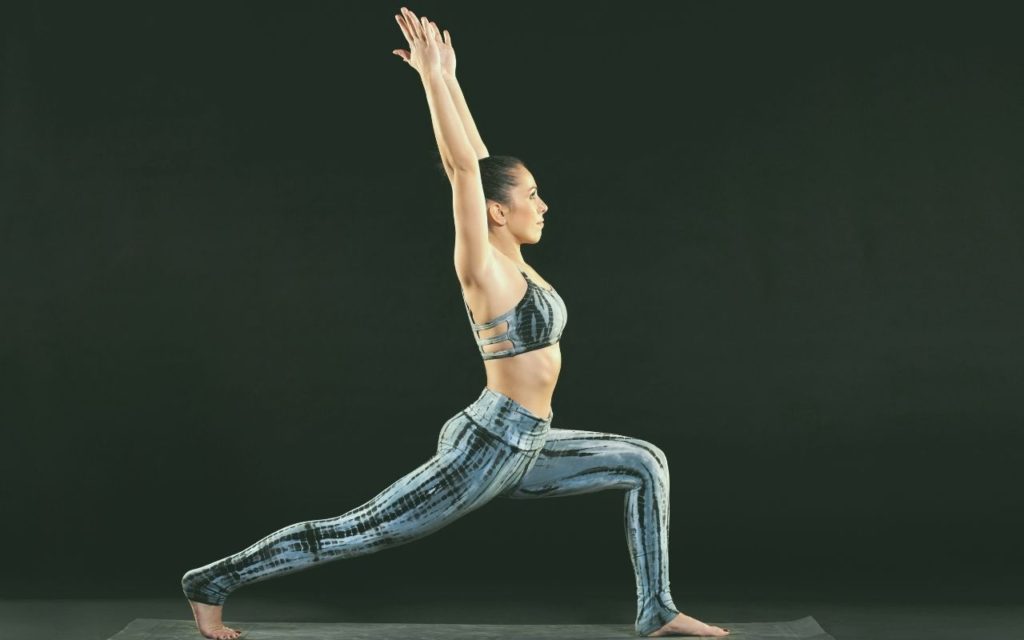
Virabhadrasana II or Warrior II pose
Take a step forward, about the length of your mat, with your left leg. Extend your arms parallel to the floor then bend the left leg at a 90-degree angle and keep the right leg straight.
Then simultaneously twist your torso and your right foot to the right. Make sure that the left foot is perpendicular to your right foot.
Hold this position for 1-5 breaths.
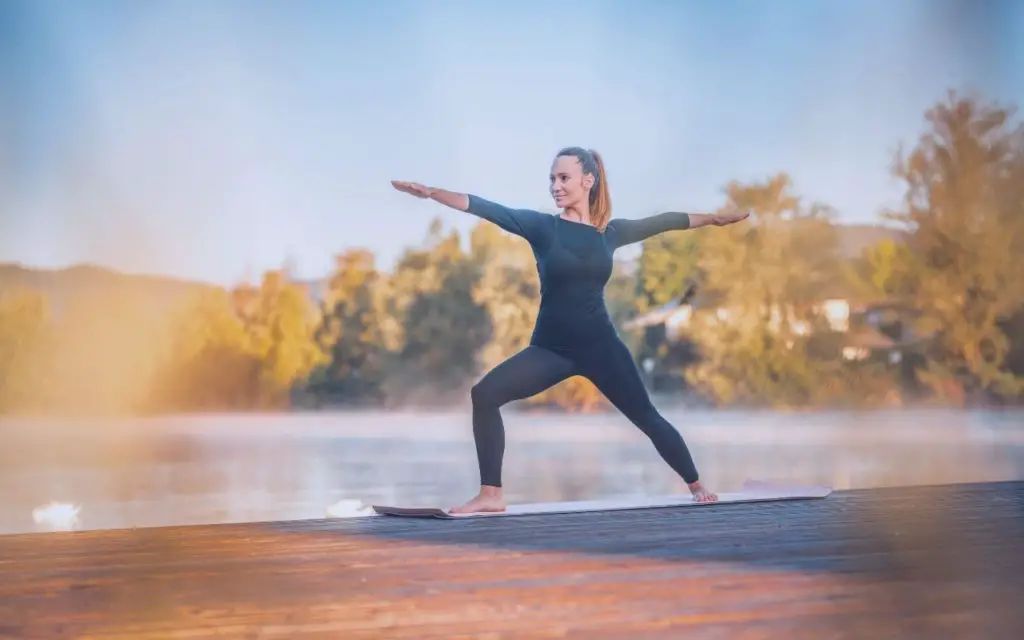
Trikonasana or Triangle pose
To do this pose, take a wide stance with your arms raised parallel to your shoulders. Point your left foot to the left and turn your face in the same direction.
Next, hinge and reach your torso over your left leg with your hips jutting back. Turn your left palm to face the ceiling and look down your left arm.
Keep your spine long and straight as you reach your left hand to the mat and place it in front of your left foot. Meanwhile, focus your attention on your right arm, which should be extended overhead.
Hold this position for 5-10 breaths and repeat on the other side.
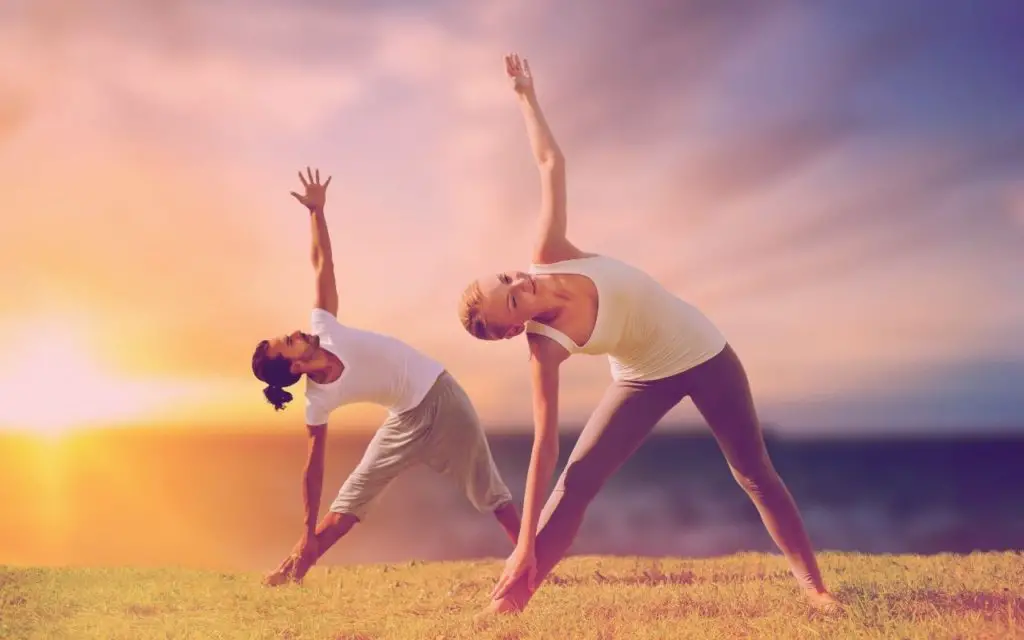
Vrksasana or Tree pose
To do this pose, start with the mountain pose, with your hands on your sides. Then place your right foot on your inner left thigh, pressing firmly into each other.
Once you found your balance, put your hands in a praying position in front of your chest. Alternatively, you can also place them overhead, like in the image below.
Focus your gaze in front of you to better keep your balance. Keep this position for 5-10 breaths, then switch sides.
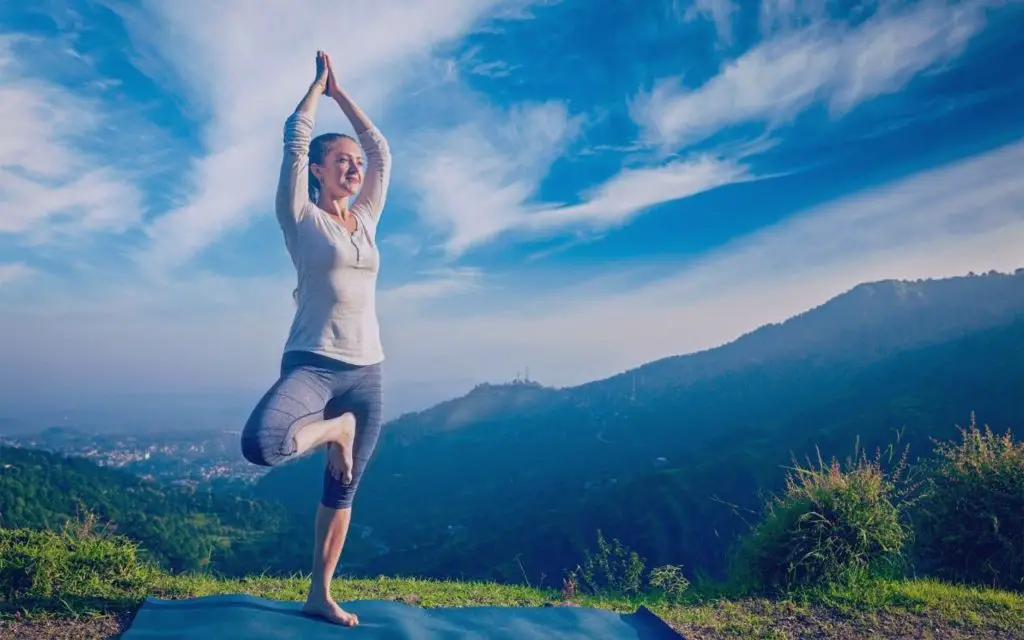
Natarajasana or Dancer’s Pose
To do the dancer’s pose, place your feet together and stand tall. Next, bend your left foot towards your glutes, and with your left hand, grab the inner arch of your left foot. Then slowly, lift your left foot towards the ceiling.
As you’re lifting your left foot, extend your right arm forward and up toward the ceiling. Again, hold this pose for 5-10 breaths and then switch sides.
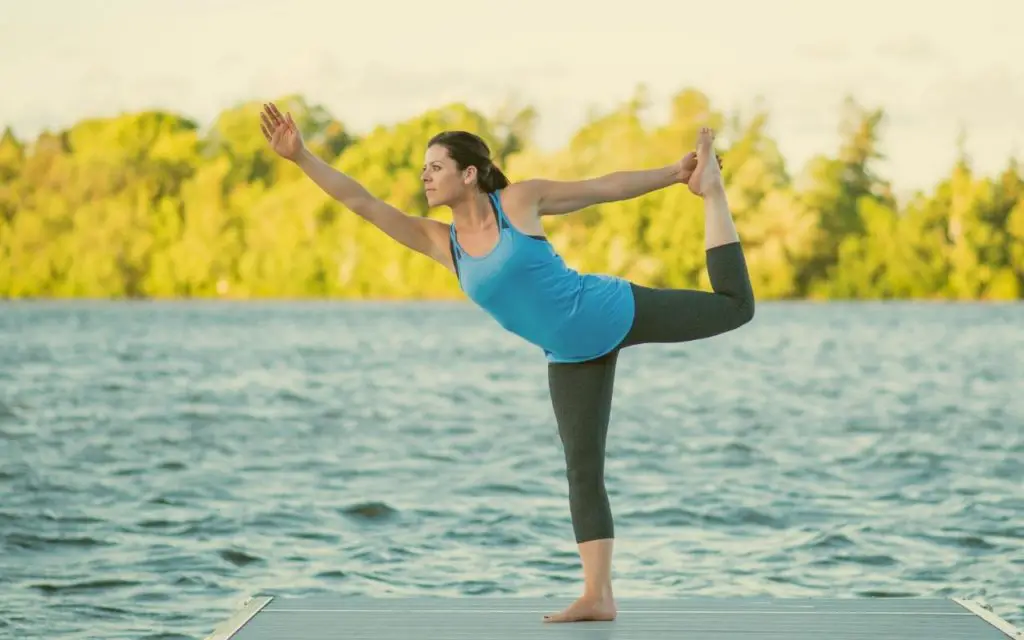
Paschimottanasana or Seated forward bend pose
For this pose, sit tall on the floor with your back straight and your legs stretched out in front of you. Then ever so slowly, bend from the hips towards your lower torso.
Reach and grab the outside of each foot if you can, if not, the farthest you can reach will do.
Then, relax and let your neck and head hang heavy for about 5-10 breaths.
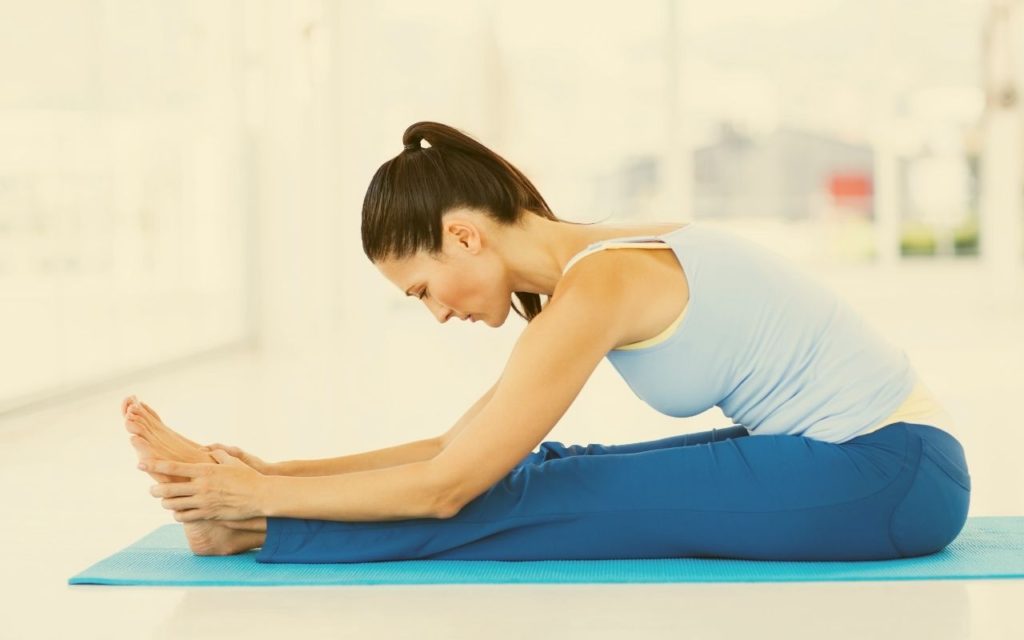
Summary
To summarize, yoga is an ancient breathing exercise with the spiritual purpose of finding enlightenment. Over the years, however, due to the other benefits that can be derived from this practice, yoga has evolved. And is now considered as a form of exercise rather than a spiritual practice.
The many benefits you can get in the practice of yoga includes, among others, the following:
- Improved flexibility,
- Toned and strengthened muscles,
- Improved posture,
- Increased metabolism,
- Improved immunity,
- Improved circulation,
- Lowered blood sugar,
- Better sleep,
- Improved heart function, and
- Improved lung function.
Aside from these physical and mental benefits, there are also practical reasons why you should choose yoga as your form of exercise, especially as a beginner.
And, for beginners who are interested in trying out yoga as an exercise, here are the best poses you can try:
- Tadasana or Mountain pose,
- Bhujangasana or Cobra pose,
- Ado Mukha Svanasana or Downward-facing dog pose,
- Utthita Ashwa Sanchalanasana or Crescent lunge pose,
- Virabhadrasana II or Warrior II pose,
- Trikonasana or Triangle pose,
- Vrksasana or Tree pose,
- Natarajasana or Dancer’s pose, and
- Paschimottanasana or Seated forward bend pose.
Please share your thoughts or ideas about How To Improve Your Health Today With Yoga For Beginners in the comments below. And if you liked this article, you might be interested as well in these articles:
Why A Running Hobby Will Improve Your Life
Walking As A Hobby What Is The Impact
What Is A Hobby And Why Is It Important
Outside resources:
Explore The Ancient Roots of Yoga
12 Must-know Yoga Poses For Beginners

I have fallen in love with yoga again. I try to incorporate a practice a day when I can.
This is a great selection of accessible poses! I love that you included the sanskrit names and included photos that clearly illustrate the poses.
Great post, Amber! I have always loved doing yoga since I was young. It is a relaxing way to exercise that gives you physical, mental, and spiritual benefits throughout your body. There are so many forms of yoga now, to benefit everyone and can be modified if needed. I have done a few posts about how yoga can help people with arthritis and osteoporosis. Thank you for sharing!